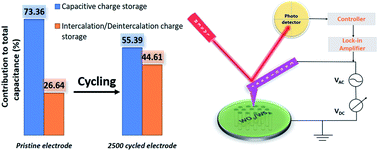Investigating 2D WS2 supercapacitor electrode performance by Kelvin probe force microscopy†
Abstract
Electrode materials used in energy storage devices undergo structural and chemical changes during cycling, which impact the long-term stability of the device. However, the phenomena behind how these changes occur at electrode surfaces remain unclear. Here we investigate the evolution of two-dimensional (2D) supercapacitor electrodes during cycling via a multifaceted approach. We propose a novel method to monitor the strain caused by cycling the 2D tungsten disulfide (WS2)-based electrode by mapping the work function of the electrode at different electrochemical cycling intervals using Kelvin Probe Force Microscopy (KPFM). To support our study, the evolution of the 2D WS2-based electrode over the course of repeated cycling is evaluated using Raman spectroscopy. The results reveal that during cycling, a strain is developed in the WS2 layers due to the intercalation/deintercalation of the electrolyte ions. As a result, the available electrochemically active sites increases leading to an increase in capacitance. This new approach enables us to understand the evolution of electrodes with cycle life and is expected to benefit the development of more efficient and long-lasting energy storage devices.



 Please wait while we load your content...
Please wait while we load your content...
